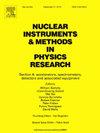Relativistic beam loading, recoil-reduction, and residual-wake acceleration with a covariant retarded-potential integrator
IF 1.4
3区 物理与天体物理
Q3 INSTRUMENTS & INSTRUMENTATION
Nuclear Instruments & Methods in Physics Research Section A-accelerators Spectrometers Detectors and Associated Equipment
Pub Date : 2024-10-21
DOI:10.1016/j.nima.2024.169988
引用次数: 0
Abstract
An algorithm is demonstrated that performs first-principles tracking of relativistic charged-particles. A covariant approach is used which relies on retarded vector potentials for trajectory integration instead of performing electromagnetic field calculations. When accounting for retardation effects, the peak vector potential and corresponding Lorentz force in the direction of travel increase asymptotically for high- particles. This produces a very strong field distribution at small angles from the particle’s direction of travel, which can result in considerable change in momentum when approaching a conducting or charged object. We study these dynamics using protons and electrons at relativistic energies passing through apertures in conducting surfaces, where substantial energy shifts are observed for particles passing within roughly of the aperture boundary.
We also simulate breaking a test particle’s line of sight with a conductor or other charged body. After this instant, the test particle continues to accelerate due to residual fields, but no longer produces an opposing force on any charged or conducting object; thus any recoil on the enclosing structure is effectively reduced. In this test, a 1% energy gain is observed for an 85 MeV electron traversing its reflected wake after having conducting plate in its path screened by a dielectric object.
We then incorporate a micro-scale dielectric laser acceleration (DLA) device into our simulations. Compared with a 2 mm DLA on its own, we find a factor of two increase in energy gain when adding a series of conducting-surface choppers.
利用协变迟滞电位积分器进行相对论束加载、反冲还原和残余唤醒加速试验
演示了一种对相对论带电粒子进行第一原理跟踪的算法。该算法采用了一种协变方法,依靠迟滞矢量势进行轨迹积分,而不是进行电磁场计算。当考虑到迟滞效应时,对于高β粒子,行进方向上的峰值矢量势和相应的洛伦兹力会近似增加。这就在与粒子运动方向成很小角度时产生了很强的场分布,在接近导电或带电物体时会导致相当大的动量变化。我们利用质子和电子在相对论能量下穿过导电表面的孔洞来研究这些动力学。我们还模拟了测试粒子与导体或其他带电体的视线断裂。在这一瞬间之后,测试粒子由于残留场的作用而继续加速,但不再对任何带电体或导电体产生反作用力;因此,包围结构上的任何反冲力都会有效减弱。在这个测试中,我们观察到一个 85 MeV 的电子在其路径上的导电板被电介质物体屏蔽后,其反射尾迹的能量增益为 1%。与单独的 2 毫米 DLA 相比,我们发现在添加一系列导电表面斩波器后,能量增益提高了两倍。
本文章由计算机程序翻译,如有差异,请以英文原文为准。
求助全文
约1分钟内获得全文
求助全文
来源期刊
CiteScore
3.20
自引率
21.40%
发文量
787
审稿时长
1 months
期刊介绍:
Section A of Nuclear Instruments and Methods in Physics Research publishes papers on design, manufacturing and performance of scientific instruments with an emphasis on large scale facilities. This includes the development of particle accelerators, ion sources, beam transport systems and target arrangements as well as the use of secondary phenomena such as synchrotron radiation and free electron lasers. It also includes all types of instrumentation for the detection and spectrometry of radiations from high energy processes and nuclear decays, as well as instrumentation for experiments at nuclear reactors. Specialized electronics for nuclear and other types of spectrometry as well as computerization of measurements and control systems in this area also find their place in the A section.
Theoretical as well as experimental papers are accepted.

 求助内容:
求助内容: 应助结果提醒方式:
应助结果提醒方式:


